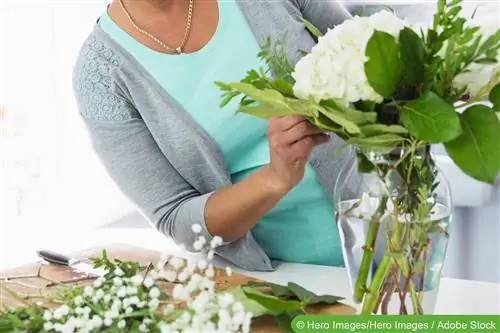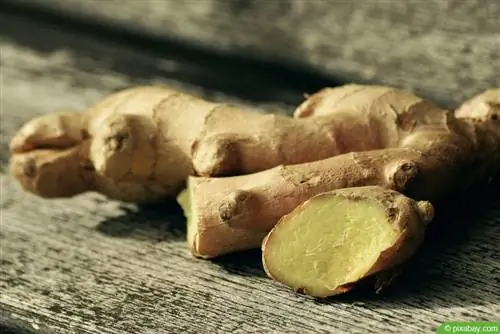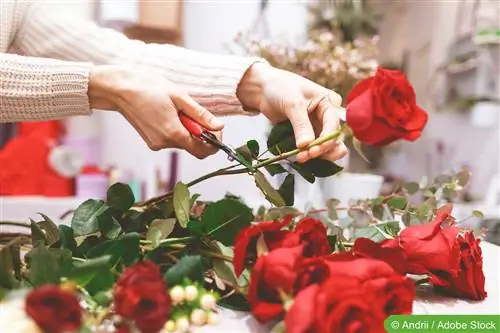- Author admin [email protected].
- Public 2023-12-17 03:39.
- Last modified 2025-06-01 06:48.
A magnificently blooming bouquet of flowers not only delights the eye of the beholder, but also exudes its own unique charm within the four walls. But after just a few days, the colorful beauties lose their strength and hang their heads. Not least because cutting it off means the source of nutrients is missing. However, the shelf life can be extended with a few simple measures. Therefore, in addition to the correct cut, the location is also crucial for the durability of the cut flowers.
General Tips
There are a number of options to protect cut flowers from premature wilting. However, everything has to be right. Starting from the vase and the water to the right cut and optimal location.
- Before the flowers go into the vase, they should be free of dust, germs and bacteria. Therefore, clean the vase thoroughly with detergent and hot water.
- Always cut cut flowers freshly and diagonally and place them in the water immediately. Orchids or cyclamens can also be lightly scratched on the stem as they require a lot of water. Plants with woody stems such as chrysanthemums are cut very diagonally and can also be split somewhat. Bevel flowers with non-woody stems only slightly. Always use a sharp knife for cutting. Scissors compress the supply lines. For sunflowers or roses, the stem ends are briefly dipped in hot water after cutting.
- In order not to contaminate the water with bacteria due to rot, all unnecessary leaves are removed.
- It is completely sufficient if the cut flowers only have their feet in the water.
- The optimal temperature of the vase water is 35 °C. Do not place cut flowers in cold or too hot water. Spring flowers such as daffodils and tulips, on the other hand, only develop their beauty in cold water.
- Many people know the trick with the copper coin. This does not extend lifespan. However, it can curb the formation of bacteria. The same effect is achieved with a little lemon juice or vinegar. Painkillers, on the other hand, do not belong in flower water.
- Sugar is also known to extend shelf life. That is only partly true. Although the plant is supplied with glucose, too much sugar in the vase water contributes to the rapid growth of bacteria. Therefore, sugar is only helpful in moderation.
- Direct sunlight causes cut flowers to wilt just as quickly as a place next to the radiator. A fresh, cool place without drafts is recommended. If the vase is kept in a cool place at night, this will extend its lifespan even further.
- Hyacinths or daffodils secrete a sticky and poisonous substance at the interface. They should stand in a separate container overnight. Then rinse the cut surface. Do not cut again.
There are special nutrient solutions for cut flowers available in stores, either in powder or liquid form. If these nutrients are added to the flower water, they delay wilting.
SOS for cut flowers
If the bouquet of flowers starts to wilt despite all the helpful tips, you can breathe life back into the cut flowers with a simple trick. To do this, immerse the weak bouquet as completely as possible in a water bath with lukewarm water. This means that the cut flowers will shine again in new splendor - even if only for a short time.
Brunched flowers
Every now and then a cut flower breaks. However, this does not have to be taken out of the vase and thrown away straight away. There is definitely a great trick to extend the lifespan of this flower. The magic word is straw. This is simply pushed from below over the stem of the cut flower to the bent point. So that the straw does not immediately catch the eye, the flower is placed in the middle of the vase. Straws or drinking straws are now available in a wide variety of colors and lengths, so that they hardly disturb the overall appearance of the beautiful bouquet of flowers.
Care instructions for roses in the vase
The queen of flowers has her own requirements when it comes to durability in the vase. Because once they are cut off from the mother plant, roses usually don't last very long. But with a few little tricks, wilting can be delayed. There are a few things that need to be taken into account during transport:
- Remove protective cover immediately after purchase to avoid rotting
- Wrap the stem ends of the roses immediately with a wet cloth
- If you don't have a cloth at hand, newspaper can also help
- Transporting the bouquet upside down
The following measures will keep roses in the vase longer:
- Only use freshly boiled, lukewarm water for the roses.
- A squeeze of lemon lowers the pH of the water.
- Cut the stem ends diagonally and rinse with cold water.
- Remove any leaves that could touch the water.
- Place roses individually in the plant to avoid pressure points.
For bouquet roses, it is important to change the water daily - as described above. It also makes sense to cut the stems again and pluck off any withered leaves. A little sugar or stale lemonade in the water will keep roses looking fresher for longer. Fresh roses should never be in a vase with older people.
Trick:
Rose petals that are starting to fade can simply be sprayed with hairspray. This means they last longer, at least visually.
Frequently asked questions
Why don't my cut flowers last longer?
The main reason for premature wilting is lack of water. Which doesn't mean that there isn't enough water in the vase. Rather, it's about the plant not being able to process the water due to various conditions. For example, when the leaves evaporate so much water that there is hardly anything left for the flowers.
Why shouldn't cut flowers be placed near fruit?
In addition to fruit, vegetables and cigarette smoke also emit ethylene gas. This ripening gas accelerates the aging process of cut flowers.
What you should know about fresh cut flowers in brief
The stems of fresh cut flowers must be cleaned thoroughly to avoid rotting in the water. For this reason, all leaves at vase height must also be removed. The flowers should be placed in water immediately after cutting to prevent air from entering the ducts. Since this is usually not possible, it is recommended to cut the stems again with a smooth knife cut and then add them to the vase immediately afterwards.
- Thorough cleaning of the vase is the top priority! You can tackle the bacteria with a brush, hot water and dishwashing liquid.
- The vase water must not be very cold - as is often wrongly assumed - but should have a temperature of approx. 35 °C.
- Special nutrient solution is a true elixir of life for cut flowers. On the one hand, it inhibits the formation of bacteria and fungi and, on the other hand, it supplies the energy necessary for life.
- The flower vase must never be placed near fruit. This gives off ethylene, a ripening gas that reduces the shelf life of plants.
- Sugar as flower food? A small pinch of sugar is useful, but too much will have the opposite effect: the flowers will rot even faster.
- A copper coin (cent coin) in the water helps to prevent the formation of rot.
- During the day, cut flowers should neither be placed in direct sunlight nor exposed to drafts. You can put them in a cool room overnight.
- A dash of vinegar or lemon juice in the vase water not only neutralizes the lime content of the water, but also prevents the development of rot.
- For hard-stemmed plants, such as sunflowers, roses or lilacs, experts recommend dipping the stems briefly in boiling water. Then place the flowers in cold water.
- Flowers that are brought into the warm room from winter temperatures should not be unpacked immediately, but rather allowed to acclimatize for about half an hour. Then remove the foil and place it in the vase.
- SOS for a wilted bouquet: Give it a water bath. The flowers and leaves may recover quickly.






